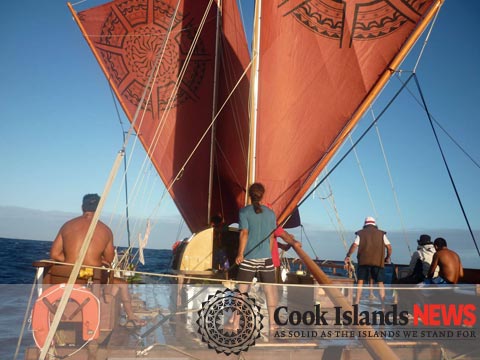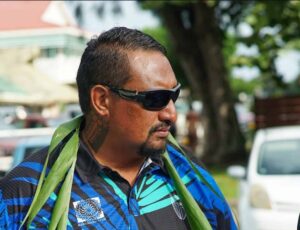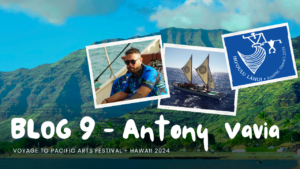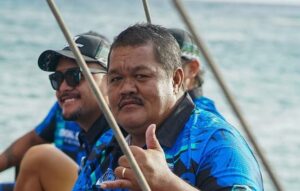In 1978 a Hawaiian Community Leader named Myron ‘Pinky’ Thompson would say the following after Hokule’a a Hawaiian voyaging canoe had capsised and crew member Eddie Aikau was lost at sea, and years later another voyage to Tahiti was being discussed: “You need to know the path that you are going and why you are going there. You need to define the values that will guide you on that path that will navigate you on your journey not only to Tahiti, but through your lives. You need to define your community, and community is never about what separates you from each other, your race or your culture, it’s about what binds you together.”
Not long after this statement Hokul’ea would sail to and back from Tahiti, continuing a wave of Hawaiian cultural awakening centred on this voyaging vaka with Myron’s son Nainoa Thompson navigating the Hokule’a as its traditional navigator. Nainoa was taught by Mau Pialug, and both men would be instrumental in training our own traditional navigators.
If there was ever a symbol or a figure that so encapsulated the mind and journey of what it is to be Polynesian, then there is none more than the vaka. As we celebrated the week-long Vaka Eiva festival it seemed pertinent to look again at this icon of the Pacific and its place as a construct in the world of Polynesia. Whether it be a song, or dance, a Pe’e or chant, or Imene Tuki, the vaka appears time and time again or at least the idea that we journeyed on a vaka from Avaiki to our enua,no matter where in Polynesia that may be. Be it a vaka, or a va’a, or waka, vaha or wa’a, the journey and how we journeyed are the same.
Vaka truly have been the arms that cradled us as we voyaged across an expanse of ocean larger than Russia and at a time when the vikings under Leif Ericson were just departing Scandinavia for northern Europe. About 1000 years after the death of Christ and 492 before Columbus left Spain to “discover” new worlds we had conquered and populated the Pacific Ocean and we were able to do this because of our vaka.
Captain Cook when he arrived in Tahiti was troubled by how this group of people at the furthermost parts of the Pacific spoke a similar language and culture no matter which part of Polynesia he arrived at. He went on to call Polynesia the most extensive nation on Earth. As a sea fearer he was astounded that we were able to build, bigger, faster and sound ships that must have carried us from place to place over the Pacific. The vaka truly is a construct, and like the word suggests it is something that we “construct” and build whether it be in our hearts and minds or with Wood and now fiberglass.
Tupaea, a Tahitian navigator that sailed with Cook, amazed him with his ability to know and navigate the South Pacific. From Tahiti to Aotearoa he was able to identify and navigate without map or instrument and was able to draw for Cook a map with 72 islands on them stretching over 2000 miles. Such was our ability and prowess over an ocean so vast. Where others saw a hurdle we saw a highway, and with that we travelled and settled.
How was a people that were deemed by 18th century European explorers as needing to be saved from themselves, being somehow savage, somehow primitive, fit only for the missionaries’ salvation, able to transverse such a large expanse of ocean without sextant, compass, map and the many other tools Europeans had depended on to conquer the world they knew.
This supposed undiscovered group of islands and people, who needed “discovering”, and civilising, and missionising, had actually lived and existed in societies with structure, language, protocol and spirituality, inter-island, for thousands of years. It would seem the question as to who actually was “enlightened” is a reasonable one to ask.
The purposed voyaging of our people in vaka carried a very precious cargo that would stand the test of time. The test of invasion, disease, technology, the evil of colonisation and colonialisim, of diminished language and culture, of capitalism and a globalisation. This taonga that was carried with us on these vaka was our identity spawned in the birth of every child that landed throughout Polynesia. For every one of us that calls ourselves Polynesian, we have descended from a vaka and because of their strength and determination I am who I am and we are who we are.
Our beautiful Vaka Marumaru Atua sits most days out in Avana for all to see. She is beautiful and strong. She takes no prisoners and when you sail on her she lets you know who is in control, and that one must be gentle and listen and learn. She has carried her crew from here to San Francisco and back and enabled so many others, myself included, to glean from her. She is a link to our past and an icon that we can touch and feel and be a part of today.
Men like our very own Sir Tom Davis, and the building of Te Au o Tonga, were of that same spirit and understood how central the vaka was to our understanding of who we are. Men like Ian Karika, Tua Pittman, Peia Patia, Tetini Pekepo, Harry Goodwin and the many men and women that have voyaged on Te Au O Tonga and Marumaru Atua ensure that this knowledge and the place of the vaka is never forgotten again.
Myron ‘Pinky’ Thompson said as the Hokule’a was about to depart for Tahiti: “The values that guided us in the past are the ones that we should use today and that will see us into the future the voyage was not just a way to right wrongs of the past – it was a journey from anger and fear toward love and courage.” I hope and pray and work constantly towards this journey of love and courage for us all here in the Cook Islands that we too can retain our identity, remember the place of the vaka in our lives and absorb the courage and determination of our Tupuna to take us forward.







